

Villa Park is a neighborhood in the city of Denver, Colorado. Its hilly topography provides panoramic views of downtown Denver and of the Rocky Mountains, particularly from Lakewood / Dry Gulch Park, which divides the neighborhood diagonally. [1]


Villa Park is a neighborhood in the city of Denver, Colorado. Its hilly topography provides panoramic views of downtown Denver and of the Rocky Mountains, particularly from Lakewood / Dry Gulch Park, which divides the neighborhood diagonally. [1]

The neighborhood is located in the area traditionally known as West Denver, about two to three miles (5 km) west of Downtown Denver. The neighborhood is bounded on the north by Lakewood Gulch, on the east by Federal Boulevard, on the south by the 6th Avenue Freeway, and on the west by Sheridan Boulevard, except for a small notch occupying a few square blocks that protrudes to the westward of Sheridan Boulevard between 10th Avenue and Lakewood Gulch. Generally, Sheridan Boulevard is the border between Jefferson County and the City and County of Denver. Feeder streets include 10th Avenue, Perry Street and Knox Court, the few streets with bridges across the major geographic barriers within the neighborhood.
The neighborhood contains three small creeks: Lakewood Gulch, which provides the northern border for the neighborhood, Dry Gulch and Weir Gulch. The confluence of Lakewood and Dry gulches is located in the neighborhood near the intersection of 10th Avenue and Osceola Street. Martinez, Paco Sanchez, Lakewood/Dry Gulch, and Barnum North parks straddle the creeks as they meander through the neighborhood. [2] Much of the areas around the creeks have a typical riparian environment and are more natural than many other areas of the city as a result. Several bike and pedestrian paths also follow the creeks and connect the neighborhood with the rest of the city. Because of the creeks and a general elevation gain towards the west, Villa Park is a very hilly neighborhood.
According to the Piton Foundation, the 2017 population of the neighborhood was 9,400. The neighborhood is about 70 percent Latino, 26 percent white and the rest from other ethnicities. The neighborhood also has a large immigrant community with more than 27 percent of residents born in another country. The most common age group is 25-34, making up about 20 percent of the neighborhood's population. The neighborhood's population is mostly middle class with an average income of about $49,000. Around 25 percent of Villa Park's population is below the poverty line. Crime rates are close to Denver averages except for somewhat higher rates of burglary. [3]
The neighborhood consists chiefly of single-family homes, with some townhomes, apartment buildings and several apartment complexes. Villa Park offers residents an urban-suburban mix feel. Commercial development exists primarily on the major thoroughfares of Sheridan and Federal Boulevards with smaller commercial areas along Sixth and 10th Avenues and Knox Court. In early 2013, the west corridor of the FasTracks was completed, running through Lakewood Gulch. The RTD W Line provides light rail service to the neighborhood with stops at Knox Court, Perry Street and Sheridan Boulevard. It is the first completed project of the FasTracks system. [4]
On March 28, 2023, the Denver City Council approved the West Area Plan, which includes Villa Park.
The neighborhood has a community group named Villa Park Neighborhood Association (VPNA). [5]
In 1871, developers bought more than 1,000 acres (4.0 km2) of land in the area that now includes Villa Park and the Barnum neighborhoods. Original plans called for a subdivision with artificial lakes, ravines and beautiful landscape design by Frederick Law Olmsted, the man who designed Central Park. The plan never came to fruition and the land was sold to a group led by Judge Hiram Bond who operated a cattle brokerage there until 1878. At that time it was sold by Bond to Helen Barnum Hurd Buchtel, the daughter of circus owner Phineas Barnum, whose family was active in Denver real estate. Because of unfavorable geography, the Villa Park was slow to develop with only about 66 buildings in the area by the 1900 census. Single-unit construction continued slowly into the 1950s when most of the neighborhood had been fully developed. In the 1960s and 1970s, more multi-unit building construction occurred in Villa Park, primarily in the western side of the neighborhood. [1]

Civic Center, Denver is a neighborhood in Denver, Colorado, United States. The northern part of the neighborhood overlaps partially with the Denver Civic Center, an area of parks and civic buildings.

The City and County of Denver, Colorado, is located at 39°43'35" North, 104°57'56" West in the Colorado Front Range region. The Southern Rocky Mountains lie to the west of Denver and the High Plains lie to the east.
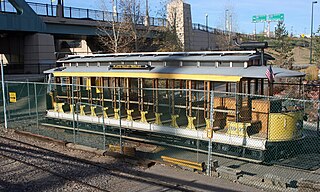
The Denver Trolley, formerly known as the Platte Valley Trolley, is a heritage streetcar line in Denver, Colorado, operated by the Denver Tramway Heritage Society. It began service on July 1, 1989.
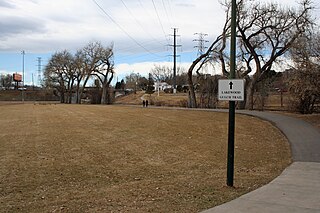
Lakewood Gulch drains a section of Lakewood and west Denver, Colorado into the South Platte River. It is the historic location of the old Interurban Shortline Railway and, in 2008, is a greenbelt that includes Rude Park, Sanchez Park and Lakewood Gulch Park. The gulch passes through Lakewood from west to east before entering the Denver neighborhoods of Sun Valley and Villa Park. It contains a part of the route of the (current) heritage streetcar Platte Valley Trolley and the Denver sections of the creek have an adjacent bike path. According to the Jefferson County Colorado Place Names Directory, "Lakewood Gulch originates on the north east foot of Green Mountain in Lakewood, flows east through Sixth Avenue West Park and Red Rocks Community College and continues east through Lakewood into Denver, where it joins the South Platte River southwest of the intersection of I-25 and Colfax Avenue."

Jefferson Park is a neighborhood and public park that overlooks Downtown Denver, Colorado from its perch across Interstate 25 (I-25). It is located in the area that is called North Denver. Views east from Jefferson Park take in Elitch Gardens Theme Park, The Children's Museum, Denver's Downtown Aquarium, Pepsi Center, the REI flagship store and other attractions in Downtown's Central Platte Valley. Downtown Denver and the Central Platte Valley are quickly accessed from Jefferson Park, using the 23rd Avenue overpass on I-25 and Water Street. In addition, the Light Rail C-Line is located by Empower Field at Mile High in the southern part of the neighborhood.

Highland is a distinct city-center neighborhood in Denver, Colorado, United States, bounded by West 38th Avenue to the north, a Union Pacific Railroad line on the east, the South Platte River to the southeast, Speer Boulevard on the south, and Federal Boulevard on the west. The Highlands is sometimes used to refer to two separate city-center neighborhoods in Denver; Highland and West Highland, although the two neighborhoods are distinct. Highland and West Highland are both in the area that is referred to as the Northside. Highland is located immediately northwest of downtown. Note that the Highland neighborhood association has a slightly different definition with the easternmost boundary stopping at I-25. And the West Highland neighborhood to the immediate west of Highland, with the borders of 38th and 29th Avenues on the north and south and Federal and Sheridan Boulevards on the east and west. To distinguish between its immediately adjacent neighbor, West Highland, Highland is sometimes referred to as East Highland, Lower Highland or LoHi. The two together are casually called "the Highlands," a term which often falsely encompasses other Northwest Denver neighborhoods such as Jefferson Park, Sunnyside and Berkeley. Realtors have particularly pushed the inclusion of the recently gentrified Berkeley, located directly north of West Highland, as part of the Highlands, sometimes going so far as to refer to Berkeley and parts of Sunnyside as the "Upper Highlands". To add further confusion, within the Highlands neighborhoods there are several historic designations of various degrees, including Potter Highlands, Scottish Highlands and Highlands Park.
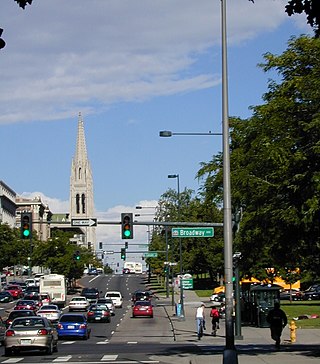
The oldest part of Denver, Colorado, now the neighborhoods of Auraria Campus, LoDo, much of downtown, and Five Points, is laid out on a grid plan that is oriented diagonal to the four cardinal directions. The rest of the city, including the eastern part of downtown, is laid out primarily on a grid oriented to the cardinal directions. In this larger grid, from east to west, there are generally 16 city blocks per mile, except between Zuni Street and Lowell Boulevard in west Denver. From north to south, there are typically eight blocks per mile, although there are many areas with more blocks per mile. Addresses follow a decimal system, with addresses advancing by one hundred at each cross street.

Berkeley is a city-center neighborhood in Denver, Colorado, located in the area traditionally called the, "Northside", on the west side of Interstate 25 and just south of Interstate 70.

Sun Valley is a neighborhood in central Denver, Colorado, bordered by I-25 on the east, Federal Blvd. on the west, 6th Avenue on the south and 20th Ave. on the north. It is located in the area known as West Denver.

Sloan Lake, also known as Sloan's Lake and Sloans Lake, is a body of water, park, and neighborhood in Denver, Colorado. The neighborhood is located on the northwest side of Denver, with the lake acting as a central feature of the neighborhood.

West Colfax is a neighborhood of Denver, Colorado. The neighborhood is located in the West Denver area. In 2015 the population of the neighborhood was 9,120, and there were 4,055 housing units.

Valverde is a neighborhood of Denver, Colorado. It is in the area known as West Denver or the "West Side". According to the Piton Foundation, in 2007, the population of the neighborhood was 4,093, and there were 1,276 housing units. Valverde home values are expected to grow substantially, due to the recent population growth in the Denver metro area. The commute to downtown Denver from the Valverde neighborhood is less than 5 minutes since the completion of 6th avenue, which no longer merges with I-25.

Barnum is a neighborhood of Denver, Colorado. The neighborhood is located in the area known as West Denver. According to the Piton Foundation, in 2007, the population of the neighborhood was 6,456, and there were 1,924 housing units.

Belcaro is a neighborhood of Denver, Colorado. According to the Piton Foundation, in 2007, the population of the neighborhood was 4,394, and there were 2,343 housing units. The neighborhood is a wealthy one, and Piton Foundation data from 2000 indicates the neighborhood's average household income was $163,553.
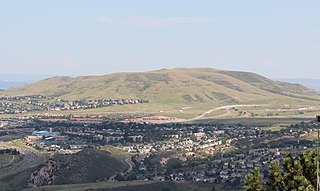
Lakewood is the home rule municipality that is the most populous municipality in Jefferson County, Colorado, United States. The city population was 155,984 at the 2020 U.S. Census, making Lakewood the fifth most populous city in Colorado and the 167th most populous city in the United States. Lakewood is a suburb of Denver and is a principal city of the Denver–Aurora–Lakewood, CO Metropolitan Statistical Area and a major city of the Front Range Urban Corridor.
Regis is a neighborhood in Denver. Located in North Denver, its boundaries are Harlan Street to the west, Clear Creek (Colorado) to the northwest, 52nd Avenue and the northern border of the Regis University campus to the north, Federal Boulevard to the east, and highway I-70 to the south. The Berkeley neighborhood is adjacent to its south end and the Chaffee Park neighborhood is adjacent to its east end. Located in the neighborhood is Regis University and the Willis Case golf course.

Sheridan is a below grade light rail station on the W Line of the RTD Rail system. It is located alongside the banks of the Lakewood Gulch under Sheridan Boulevard, after which the station is named. The station straddles the border between Denver and Lakewood, Colorado, but RTD lists the station as being in the city of Denver. A marking etched into the platform indicates the border location.

Decatur–Federal is an at-grade light rail station on the W Line of the RTD Rail system. It is located alongside the banks of the Lakewood Gulch between its intersections with Decatur Street and Federal Boulevard, after which the station is named, in Denver, Colorado. The station is located in the Sun Valley neighborhood, near the point where Lakewood Gulch meets the South Platte River. It is one of two light rail stops that serve Empower Field at Mile High, the home stadium of the Denver Broncos. The stop is adjacent to Rude Park.
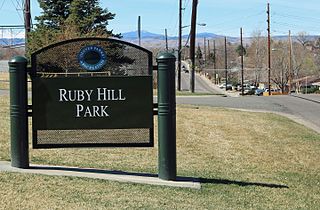
Ruby Hill is a neighborhood in southwest Denver, Colorado. The neighborhood takes its name from Ruby Hill, a 5,390 ft (1,640 m) elevation hill in the neighborhood that overlooks much of South Denver. The hill itself was named for red stones found in the area by early miners, stones that turned out to be garnets.